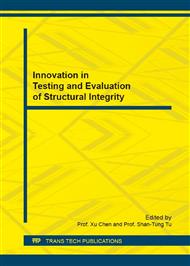[1]
M.G. Rashed, M. Ashraf, R.A.W. Mines, P.J. Hazell, Metallic microlattice materials: A current state of the art on manufacturing, mechanical properties and applications, Mater. Des. 95 (2016) 518–533. doi: 10. 1016/j. matdes. 2016. 01. 146.
DOI: 10.1016/j.matdes.2016.01.146
Google Scholar
[2]
R.A.W. Mines, On the characterisation of foam and micro-lattice materials used in sandwich construction, Strain. 44 (2008) 71–83. doi: 10. 1111/j. 1475-1305. 2008. 00399. x.
DOI: 10.1111/j.1475-1305.2008.00399.x
Google Scholar
[3]
O. Rehme, Cellular design for laser freeform fabrication, Cuvillier, (2010).
Google Scholar
[4]
S.K. Everton, M. Hirsch, P. Stravroulakis, R.K. Leach, A.T. C lare, Review of in-situ process monitoring and in-situ metrology for metal additive manufacturing, Mater. Des. (2016). doi: 10. 1016/j. matdes. 2016. 01. 099.
DOI: 10.1016/j.matdes.2016.01.099
Google Scholar
[5]
Advances in production technology, Springer International Publishing, 2015. http: /link. springer. com/chapter/10. 1007/978-3-319-12304-2.
Google Scholar
[6]
D.D. Arola, M.L. McCain, Abrasive waterjet peening: A new method of surface preparation for metal orthopedic implants, J. Biomed. Mater. Res. 53 (2000) 536–546. doi: 10. 1002/1097-4636(200009)53: 5<536: AID-JBM13>3. 0. CO; 2-V.
DOI: 10.1002/1097-4636(200009)53:5<536::aid-jbm13>3.0.co;2-v
Google Scholar
[7]
R. Gümrük, R.A.W. Mines, Compressive behaviour of stainless steel micro-lattice structures, Int. J. Mech. Sci. 68 (2013) 125–139. doi: 10. 1016/j. ijmecsci. 2013. 01. 006.
DOI: 10.1016/j.ijmecsci.2013.01.006
Google Scholar
[8]
C.C. Seepersad, J.K. Allen, D.L. McDowell, F. Mistree, Robust design of cellular materials with topological and dimensional imperfections, J. Mech. Des. 128 (2006) 1285–1297. doi: 10. 1115/1. 2338575.
DOI: 10.1115/1.2338575
Google Scholar
[9]
C. Qiu, S. Yue, N.J.E. Adkins, M. Ward, H. Hassanin, P.D. Lee, et al., Influence of processing conditions on strut structure and compressive properties of cellular lattice structures fabricated by selective laser melting, Mater. Sci. Eng. A. 628 (2015).
DOI: 10.1016/j.msea.2015.04.074
Google Scholar
[10]
P. Mercelis, J. Kruth, Residual stresses in selective laser sintering and selective laser melting, Rapid Prototyp. J. 12 (2006) 254–265. doi: 10. 1108/13552540610707013.
DOI: 10.1108/13552540610707013
Google Scholar
[11]
O. Cansizoglu, O.L.A. Harrysson, H.A. West, D.R. Cormier, T. Mahale, Applications of structural optimization in direct metal fabrication, Rapid Prototyp. J. 14 (2008) 114–122. doi: 10. 1108/13552540810862082.
DOI: 10.1108/13552540810862082
Google Scholar
[12]
P. Li, Constitutive and failure behaviour in selective laser melted stainless steel for microlattice structures, Mater. Sci. Eng. A. 622 (2015) 114–120. doi: 10. 1016/j. msea. 2014. 11. 028.
DOI: 10.1016/j.msea.2014.11.028
Google Scholar
[13]
G. Pyka, A. Burakowski, G. Kerckhofs, M. Moesen, S. Van Bael, J. Schrooten, et al., Surface modification of Ti6Al4V open porous structures produced by additive manufacturing, Adv. Eng. Mater. 14 (2012) 363–370. doi: 10. 1002/adem. 201100344.
DOI: 10.1002/adem.201100344
Google Scholar
[14]
Standard specification for additive manufacturing titanium-6 aluminum-4 vanadium with powder bed fusion, ASTM International, West Conshohocken, PA, 2014. www. astm. org.
DOI: 10.1520/f2924-12
Google Scholar
[15]
M.G. Rashed, M. Ashraf, P.J. Hazell, Evaluation of rate-dependent plasticity models in numerical simulation of metallic light-weight microlattice materials, in: Proc. Eighth Int. Conf. Adv. STEEL Struct., University of Lisbon, Lisbon, Portugal, (2015).
Google Scholar
[16]
M. Smith, The compressive response of novel lattice structures subjected to static and dynamic loading, PhD thesis, University of Liverpool, (2012).
Google Scholar
[17]
S. Lee, F. Barthelat, J.W. Hutchinson, H.D. Espinosa, Dynamic failure of metallic pyramidal truss core materials – Experiments and modeling, Int. J. Plast. 22 (2006) 2118–2145. doi: 10. 1016/j. ijplas. 2006. 02. 006.
DOI: 10.1016/j.ijplas.2006.02.006
Google Scholar
[18]
A. Ramasubramaniam, E.A. Carter, Coupled quantum–atomistic and quantum–continuum mechanics methods in materials research, MRS Bull. 32 (2007) 913–918. doi: 10. 1557/mrs2007. 188.
DOI: 10.1557/mrs2007.188
Google Scholar
[19]
L. Valdevit, S.W. Godfrey, T.A. Schaedler, A.J. Jacobsen, W.B. Carter, Compressive strength of hollow microlattices: Experimental characterization, modeling, and optimal design, J. Mater. Res. 28 (2013) 2461–2473. doi: 10. 1557/jmr. 2013. 160.
DOI: 10.1557/jmr.2013.160
Google Scholar


